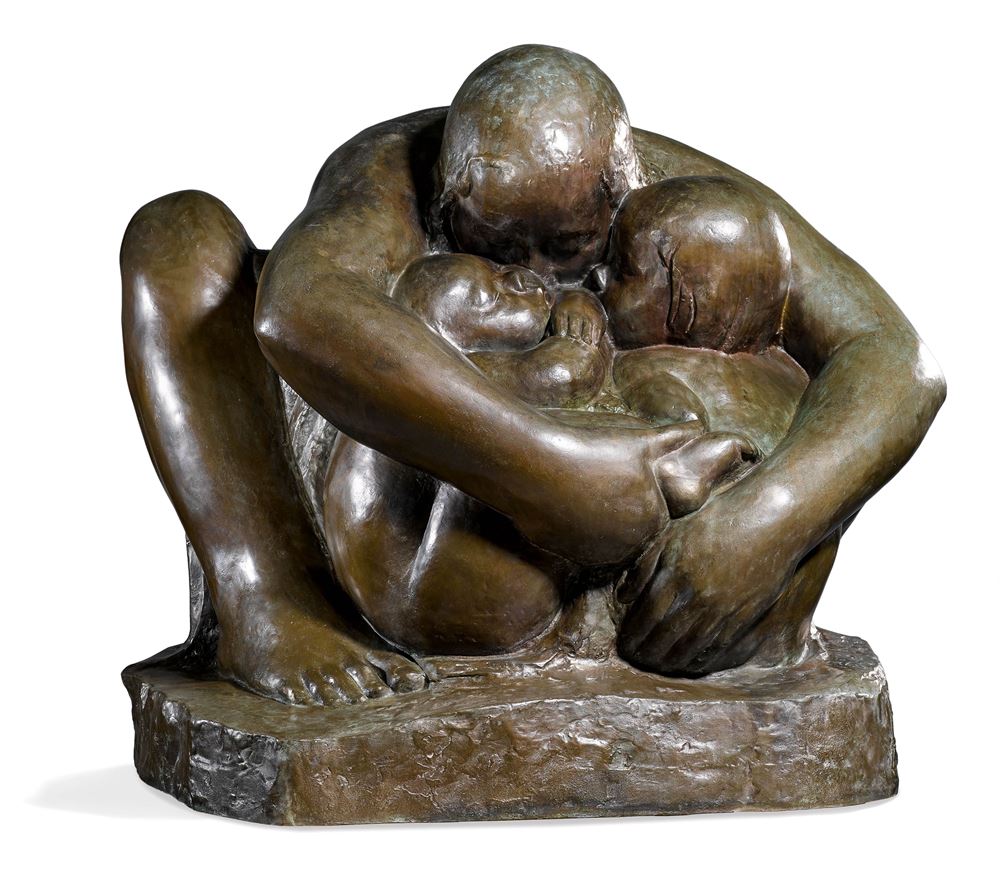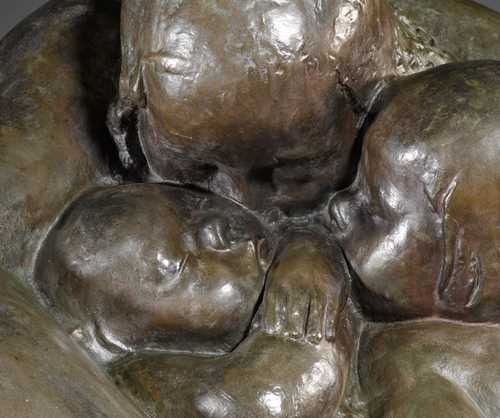
拍品 3267 - A201 印象派&现代主义 - Freitag, 01. Juli 2022, 05.00 PM
KÄTHE KOLLWITZ
(Königsberg 1867–1945 Moritzburg)
Mutter mit zwei Kindern (Mother with two children). 1932–36.
Bronze, grey-brown patina. Cast circa 1990.
Signed and with the foundry mark on the reverse lower right: Kollwitz / H. NOACK BERLIN.
77 × 79 × 84 cm.
Provenance:
- Arne Kollwitz, Berlin.
- Galerie Ludorff, Düsseldorf, acquired circa 1991 from the above.
- Swiss private collection, acquired from the above gallery on 26.3.1993.
Literature:
- Annette Seeler and Käthe Kollwitz Museum: Käthe Kollwitz: Die Plastik. Werkverzeichnis, Cologne 2016, online version, p. 31, no. I.B.9a.
- Hannelore Fischer and Käthe Kollwitz Museum: Käthe Kollwitz. Der Werküberblick, Cologne 2022, p. 265 (with ill. other cast).
"You must become a mother. The older I become, the more it seems like the most beautiful thing in life" (Kollwitz to Anna Erika Gampp, Christmas 1919).
Hardly any artist is able to capture motherly love as impressively and genuinely as Käthe Kollwitz. Throughout her career, the German artist intensively explored the theme of mother and child. In addition to being an artist and wife, she was passionately fond of being a mother herself, loved children and placed a great deal of importance on family life. In her practice, this intimate portrayal found its expression in prints, drawings and sculpture.
Of an impressive size, this bronze depicts a nude mother sitting on the floor with her arms and legs enveloping her two children, a toddler and a baby. Mother and children are enwined head to head and with closed eyes in a warm embrace. It is the depiction of motherhood in its most natural form: s scene of complete tranquillity, illustrating the unconditional love, comfort and care between a mother and her children.
The monumental bronze sculpture "Mother with Two Children" is the artist's most important work, not only treating this theme, but also within her entire sculptural oeuvre. In 1901 and 1904, the young Kollwitz travelled to Paris, where she visited her idol Auguste Rodin in his studio. The director of the Berlin National Gallery, Hugo von Tschudi, had personally asked the sculptor to receive the talented artist from Germany. She attended a two-month sculpture course at the Académie Julian, although it was not until around 1910 that she turned her attention more seriously to sculpture.
Kollwitz had already conceived of the idea for a group of a mother and a child as early as 1912, but the execution of the masterpiece would have to wait another 20 years or so. "This work had been in me for a long time before I began to form it. But I had only ever thought of one child, whereas the truly maternal embrace is not satisfied with just one child" (Fischer 2022, p. 250). In 1923, her twin granddaughters Jördis and Jutta came into the world. Their birth prompted the artist to include not one, but two children in the composition. In 1932 Kollwitz finally began work on the sculpture.
The original model of the sculpture, first created in clay, then cast in plaster, was completed in 1936. The first two bronze casts were produced at the end of the 1950s by the foundry Giesserei Schmäke in Düsseldorf. From the late 1970s onwards, a further 10 bronze casts were produced by the foundry Giesserei Noack in Berlin and were intended for commercial distribution. Of these 10 casts, most are in public institutions and only a few are still in private collections. The present bronze is only the second cast to ever be offered at auction. The only other bronze until now to be offered at auction was sold in 2007, to the Art Mia Foundation in Beijing.
- Arne Kollwitz, Berlin.
- Galerie Ludorff, Düsseldorf, acquired circa 1991 from the above.
- Swiss private collection, acquired from the above gallery on 26.3.1993.
Literature:
- Annette Seeler and Käthe Kollwitz Museum: Käthe Kollwitz: Die Plastik. Werkverzeichnis, Cologne 2016, online version, p. 31, no. I.B.9a.
- Hannelore Fischer and Käthe Kollwitz Museum: Käthe Kollwitz. Der Werküberblick, Cologne 2022, p. 265 (with ill. other cast).
"You must become a mother. The older I become, the more it seems like the most beautiful thing in life" (Kollwitz to Anna Erika Gampp, Christmas 1919).
Hardly any artist is able to capture motherly love as impressively and genuinely as Käthe Kollwitz. Throughout her career, the German artist intensively explored the theme of mother and child. In addition to being an artist and wife, she was passionately fond of being a mother herself, loved children and placed a great deal of importance on family life. In her practice, this intimate portrayal found its expression in prints, drawings and sculpture.
Of an impressive size, this bronze depicts a nude mother sitting on the floor with her arms and legs enveloping her two children, a toddler and a baby. Mother and children are enwined head to head and with closed eyes in a warm embrace. It is the depiction of motherhood in its most natural form: s scene of complete tranquillity, illustrating the unconditional love, comfort and care between a mother and her children.
The monumental bronze sculpture "Mother with Two Children" is the artist's most important work, not only treating this theme, but also within her entire sculptural oeuvre. In 1901 and 1904, the young Kollwitz travelled to Paris, where she visited her idol Auguste Rodin in his studio. The director of the Berlin National Gallery, Hugo von Tschudi, had personally asked the sculptor to receive the talented artist from Germany. She attended a two-month sculpture course at the Académie Julian, although it was not until around 1910 that she turned her attention more seriously to sculpture.
Kollwitz had already conceived of the idea for a group of a mother and a child as early as 1912, but the execution of the masterpiece would have to wait another 20 years or so. "This work had been in me for a long time before I began to form it. But I had only ever thought of one child, whereas the truly maternal embrace is not satisfied with just one child" (Fischer 2022, p. 250). In 1923, her twin granddaughters Jördis and Jutta came into the world. Their birth prompted the artist to include not one, but two children in the composition. In 1932 Kollwitz finally began work on the sculpture.
The original model of the sculpture, first created in clay, then cast in plaster, was completed in 1936. The first two bronze casts were produced at the end of the 1950s by the foundry Giesserei Schmäke in Düsseldorf. From the late 1970s onwards, a further 10 bronze casts were produced by the foundry Giesserei Noack in Berlin and were intended for commercial distribution. Of these 10 casts, most are in public institutions and only a few are still in private collections. The present bronze is only the second cast to ever be offered at auction. The only other bronze until now to be offered at auction was sold in 2007, to the Art Mia Foundation in Beijing.
CHF 130 000 / 170 000 | (€ 134 020 / 175 260)
以瑞士法郎銷售 CHF 183 300 (包含買家佣金)
所有信息随时可能更改。






